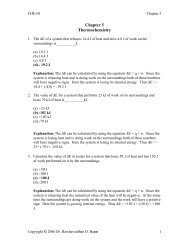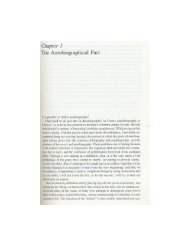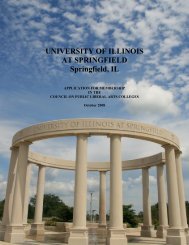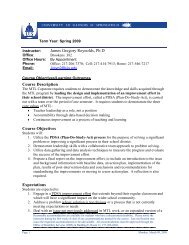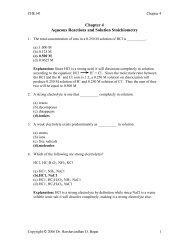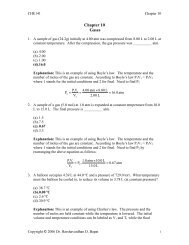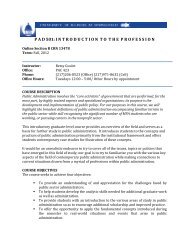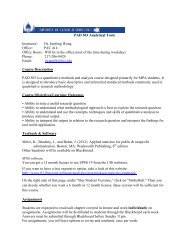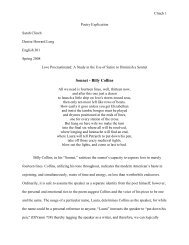Chapter 9 Molecular Geometry and Bonding Theories - eDocs
Chapter 9 Molecular Geometry and Bonding Theories - eDocs
Chapter 9 Molecular Geometry and Bonding Theories - eDocs
You also want an ePaper? Increase the reach of your titles
YUMPU automatically turns print PDFs into web optimized ePapers that Google loves.
CHE141 <strong>Chapter</strong> 9slightly larger electron domain which disrupts the ideal 120° Cl-C-Cl bond angle,making it smaller.OClCCl15. The molecular geometry of the left-most carbon atom in the molecule below is__________.OHC HH C O(a). trigonal planar(b). tetrahedral(c). trigonal bipyramidal(d). octahedralHExplanation: When working with a molecule that has more than one central atomalways concentrate on counting the number of electron domains around the particularcentral atom in question. Here the left most C atom has 4 electron domains around it<strong>and</strong> no lone pairs. As a result of this the geometry around it would be tetrahedral.16. The molecular geometry of the right-most carbon in the molecule below is__________.HHCOCOH(a). T-shaped(b). trigonal planar(c). tetrahedral(d). octahedralHExplanation: When working with a molecule that has more than one central atomalways concentrate on counting the number of electron domains around the particularcentral atom in question. Here the right most C atom has 3 electron domains aroundit <strong>and</strong> no lone pairs. As a result of this the geometry around it would be trigonalplanar.Copyright © 2006 Dr. Harshavardhan D. Bapat 5
CHE141 <strong>Chapter</strong> 917. An electron domain consists of __________(a). a nonbonding pair of electrons(b). a single bond(c). a multiple bond(a). a <strong>and</strong> b only(b). b <strong>and</strong> c only(c). a <strong>and</strong> c only(d). a, b, <strong>and</strong> cExplanation: Electron domains are regions where valence electrons are most likelyto be present. These electrons may be present as a non-bonding pair or a bonding pairof electrons.18. According to VSEPR theory, if there are three electron domains on a central atom,they will be arranged such that the angles between the domains are __________.(a). 90°(b). 180°(c). 109.5°(d). 120°Explanation: According to the VSEPR theory the best arrangement of a givennumber of electron domains is the one that minimizes the repulsions between thepairs. Thus for 3 electron domains the best arrangement will be the one with anglesof 120°.19. According to VSEPR theory, if there are four electron domains on a central atom,they will be arranged such that the angles between the domains are __________.(a). 120°(b). 109.5°(c). 180°(d). 90°Explanation: According to the VSEPR theory the best arrangement of a givennumber of electron domains is the one that minimizes the repulsions between thepairs. Thus for 4 electron domains the best arrangement will be the one with anglesof 109.5°.Copyright © 2006 Dr. Harshavardhan D. Bapat 6
CHE141 <strong>Chapter</strong> 920. The electron-domain geometry <strong>and</strong> the molecular geometry of a molecule of thegeneral formula AB n are __________.(a). never the same(b). always the same(c). sometimes the same(d). not related to each otherExplanation: The electron domain geometry of a molecule describes the arrangementof the electron domains in the molecule while the molecular geometry describes thearrangement of the actual atoms in the molecule.The presence of non-bonding electron pairs can affect the molecular geometrymaking it different than the electron domain geometry.21. The electron-domain geometry <strong>and</strong> the molecular geometry of a molecule of thegeneral formula AB n will always be the same if __________.(a). there are no lone pairs on the central atom(b). there is more than one central atom(c). n is greater than four(d). the octet rule is obeyedExplanation: The presence of lone pairs on the central atom can alter the electrondomain geometry of the molecule. The two geometries can be the same only if thereare no lone pairs present on the central atom.22. For molecules of the general formula AB n , n can be greater than four _________.(a). for any element A(b). only when A is boron or beryllium(c). only when A is an element from the third period or below the third period(d). only when A is KrExplanation: The value of “n” can be greater than 4 only the element “A” is from thethird or higher period of the periodic table. Elements from these periods can havemore than 8 electrons around their atoms (have exp<strong>and</strong>ed octets).23. Of the molecules below, only __________ is polar.(a). CCl 4(b). CH 4(c). SiCl 4(d). SeF 4Explanation: The polarity of a molecule is closely related to its electron domain <strong>and</strong>molecular geometries. Both the electron domain <strong>and</strong> molecular geometries of CCl 4 ,Copyright © 2006 Dr. Harshavardhan D. Bapat 7
CHE141 <strong>Chapter</strong> 9CH 4 <strong>and</strong> SiCl 4 are tetrahedral. The molecular geometry of SeF 4 is see-saw while theelectron-domain geometry is trigonal bipyramidal due to a lone pair on the central Seatom. As a result of the lone pair on the central atom, this molecule becomes polar.24. Of the molecules below, which one is nonpolar?FSeFFF(a). BF 3(b). NF 3(c). IF 3(d). PBr 3Explanation: With the exception of the BF 3 molecule all the other molecules willhave one or more lone pairs on the central atom. As a result of the lone pair(s) themolecule will then be polar. In BF 3 the polar B-F bonds will cancel each other,making the molecule non-polar.25. Three sulfur fluorides are observed: SF 2 , SF 4 , <strong>and</strong> SF 6 . Of these, __________ is/arepolar.(a). SF 2 only(b). SF 2 <strong>and</strong> SF 4 only(c). SF 4 only(d). SF 6 onlyExplanation: The polarity of a molecule is closely related to its electron domain <strong>and</strong>molecular geometries. Here, SF 6 has an octahedral geometry <strong>and</strong> does not have anyelectrons on the central S atom. As a result of this the polar S-F bonds cancel eachother’s pulls. In both the other fluorides, the central S atom has lone pairs on itmaking them polar molecules.26. The molecular geometry of the BeCl 2 molecule is __________, <strong>and</strong> this molecule is__________.(a). linear, nonpolar(b). linear, polar(c). bent, nonpolar(d). bent, polarExplanation: The polarity of a molecule is closely related to its electron domain <strong>and</strong>molecular geometries. The Lewis structure of this molecule clearly shows that theCopyright © 2006 Dr. Harshavardhan D. Bapat 8
CHE141 <strong>Chapter</strong> 9molecule is linear <strong>and</strong> since the central Be atom does not have any lone pairs on it,the polar Be-Cl bonds will negate each other making it a non-polar molecule.ClBeCl27. For molecules with only one central atom, how many lone pairs on the central atomguarantees molecular polarity?(a). 1(b). 2(c). 1 or 2(d). Any number greater than 1.Explanation: The polarity of a molecule is closely related to its electron domain <strong>and</strong>molecular geometries. The presence of one lone pair of electrons on the central atommakes the molecule polar, even if other bonds in the molecule may cancel each other.28. According to valence bond theory, which orbitals overlap in the formation of thebond in HBr?(a). 1s on H <strong>and</strong> 4s on Br(b). 1s on H <strong>and</strong> 4p on Br(c). 1s on H <strong>and</strong> 3p on Br(d). 2s on H <strong>and</strong> 4p on BrExplanation: According to the valence bond theory bonds are formed due to overlapsbetween valence orbitals. In the case of the HBr molecule the valence electrons arecontained in the 1s orbital for H <strong>and</strong> in the 4p orbital for the Br. The 4s orbital is full<strong>and</strong> does not have any room.29. The combination of two atomic orbitals results in the formation of __________molecular orbitals.(a). 1(b). 2(c). 3(d). 0Explanation: The combination of two atomic orbitals always leads to the formationof a bonding <strong>and</strong> an antibonding molecular orbital.Copyright © 2006 Dr. Harshavardhan D. Bapat 9
CHE141 <strong>Chapter</strong> 933. The hybridizations of bromine in BrF 5 <strong>and</strong> of arsenic in AsF 5 are __________ <strong>and</strong>__________, respectively.(a). sp 3 , sp 3 d(b). sp 3 d, sp 3 d 2(c). sp 3 d, sp 3(d). sp 3 d 2 , sp 3 dExplanation: The Lewis structures of these molecules indicate that the BrF 5 willhave an octahedral electron-domain geometry where as the AsF 5 will have trigonalbipyramidal geometry. The central Br atom will thus need 6 electron domains toaccommodate the 5 Br-F bonds <strong>and</strong> the lone pair. The central As atom on the otherh<strong>and</strong> will need only 5 electron domains to bond with the 5 F atoms.FFFFBrFFFAsFFFConsider the following species when answering questions 34 <strong>and</strong> 35:(i) PCl 3 (ii) CCl 4 (iii) TeCl 4 (iv) XeF 4 (v) SF 634. In which of the molecules does the central atom utilize d orbitals to form hybridorbitals?(a). (i) <strong>and</strong> (ii)(b). (iii) only(c). (i) <strong>and</strong> (v)(d). (iii), (iv), <strong>and</strong> (v)Explanation: Molecules with central atoms from the third period <strong>and</strong> beyond canhave an exp<strong>and</strong>ed octet; meaning more than 4 pairs of electrons around them. To dothis the atoms use their empty d orbitals. Of all the species here, only Te, Xe <strong>and</strong> S fitthis requirement <strong>and</strong> hence will utilize the d orbitals to form hybrid molecularorbitals.Copyright © 2006 Dr. Harshavardhan D. Bapat 11
CHE141 <strong>Chapter</strong> 935. Which of the molecules has a see-saw shape?(a). (i) only(b). (ii) only(c). (iii) only(d). (iv) onlyExplanation: The Lewis structures of the species involved clearly show that only theTeCl 4 will have a see-saw shape.ClClFClPClClClCClClClClClFFXeFFFFSFFFCopyright © 2006 Dr. Harshavardhan D. Bapat 12



